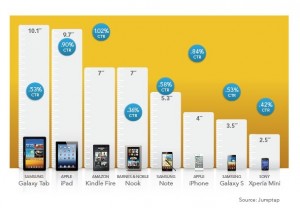When it comes to selling advertising space, it makes sense that bigger is better. Billboards reach more people than bus stop ads. That may not translate entirely to the tablet PC, however. In a recent report, mobile advertising company Jumptap revealed that Kindle Fire ads are the most successful at getting customers to click through, despite the relatively smaller screen space they have to work with compared to the competition.
 It seems that while the iPad has had the most success for its advertisers up until now, with .9% of those who view a given ad choosing to click through to the product, the Kindle Fire has already bumped itself up to 1.02%. That is nearly twice the success rate that the closest non-Apple competition has enjoyed, as shown by the Jumptap graphic to the right.
It seems that while the iPad has had the most success for its advertisers up until now, with .9% of those who view a given ad choosing to click through to the product, the Kindle Fire has already bumped itself up to 1.02%. That is nearly twice the success rate that the closest non-Apple competition has enjoyed, as shown by the Jumptap graphic to the right.
This actually seems to support the general trend for those who choose to invest in the Kindle Fire. We have already seen that Android developers enjoy something like three times the income through Amazon that the same app tends to bring in through Google’s own marketplace. Now advertisers are learning the same thing. Perhaps the only truly surprising bit of information here is that the Kindle Fire beat out the iPad. As mentioned, shouldn’t bigger ads be better ads?
The Jumptap theory is that this is the result of a generation gap. Kindle Fire owners are significantly more likely to be in the 45 to 64 year old range, which differs from iPad owners who are far more likely to come from the 18 to 34 year old range. They suggest that while these older users are generally less likely to buy products on the device itself, potentially limiting the impact of some ad campaigns, it is worth coming up with ads optimized for the Kindle Fire’s smaller screen in order to take advantage of the click-through rate.
To illustrate, they used the example of fast food advertisements. It seems these were tending to catch much more attention on weekends than during the week, but they are obviously the sort of small, quick graphic that can appeal to any demographic even when the product isn’t something offered through a given device.
Since we have a wealth of information available to properly tailor ads to their recipients in many cases, it seems like we have reached the point where size doesn’t matter. Or at least a point where size matters less. We can’t predict yet what effect a larger Kindle Fire will have on this data when Amazon gets around to releasing one, so it might just be a matter of Amazon customers being more predisposed to click on ads they find potentially interesting for all I know.
It’s always going to be up to developers to decide how best to monetize their product and this once again shows that Amazon’s platform is a superior choice. The more we see of this, the more likely we are to see wider adoption of the Amazon Appstore for Android. As a Kindle Fire user, even one who hates these very ads, that means this comes across as good news.
Another click-through-rate article? Really? Clicks mean nothing.
Boris,
I think that depends on the goal. Properly targeted advertising that is not looking for an immediate sale could probably be measured by clicks. Maybe not necessarily the best way to advertise a specific event or sale, but in terms of brand recognition and such I could see advantages. That comes as the interpretation of somebody extremely poorly versed in advertising methodology, of course.